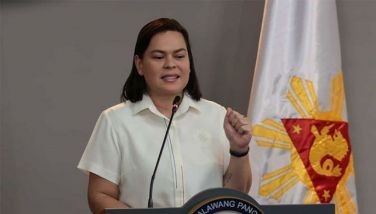Coral transplantation feasible — UP study
September 14, 2003 | 12:00am
Ever heard of coral transplantation?
This technology is gradually taking shape from a research project being done by the UP Marine Science Institute (UP-MSI) in Diliman, Quezon City.
Funded by the Department of Agriculture-Bureau of Agricultural Research (DA-BAR), the ongoing three-year project is being conducted by a team headed by Dr. Helen T. Yap in Tayabas Bay off Padre Burgos, Quezon.
The project aims to initiate the rehabilitation of damaged reefs in selected areas in the country based on proven experimental techniques and sound ecological principles.
It also seeks to enhance the diversity of fish and associated reef organisms through such interventions, and thus contribute to fisheries productivity; and to improve the affected reefs’ asthetic qualities to enhance their potential for tourism and recreational activities of the local communities.
Three species of corals were transplanted in the experimental sites: Acropora palifera, a submassive species with thick branches; Porites cylindrica, a branching species; and Porites lobata, a species with massive form.
"The reefs around Padre Burgos are severely degraded probably by blast and cyanide fishing," Dr. Yap noted. "The hard coral cover is 10 percent or less."
A portion with relatively good coral cover (40 percent) and five to 10 meters deep has been identified on the southwestern side of Dampalitan Island.
Healthy coral colonies from the reef with good coral cover were transferred to four transplant sites around the shallower (1.5-3m) portions of the island. An empty control site was set up near each transplant site for purposes of comparison of organism recruitment.
"In general," noted Dr. Yap, "the results of survival of corals in all sites were favorable except for Site 2 which appears to have higher mortality. The cause for this seems to be water turbulence since a number of transplants had been dislodged and lost."
Moreover, she said, the number of fishes varied from site to site and quarter to quarter, but generally there were more individuals in the transplant plots and source sites as compared to the empty controls and empty plots. – Rudy A. Fernandez
This technology is gradually taking shape from a research project being done by the UP Marine Science Institute (UP-MSI) in Diliman, Quezon City.
Funded by the Department of Agriculture-Bureau of Agricultural Research (DA-BAR), the ongoing three-year project is being conducted by a team headed by Dr. Helen T. Yap in Tayabas Bay off Padre Burgos, Quezon.
The project aims to initiate the rehabilitation of damaged reefs in selected areas in the country based on proven experimental techniques and sound ecological principles.
It also seeks to enhance the diversity of fish and associated reef organisms through such interventions, and thus contribute to fisheries productivity; and to improve the affected reefs’ asthetic qualities to enhance their potential for tourism and recreational activities of the local communities.
Three species of corals were transplanted in the experimental sites: Acropora palifera, a submassive species with thick branches; Porites cylindrica, a branching species; and Porites lobata, a species with massive form.
"The reefs around Padre Burgos are severely degraded probably by blast and cyanide fishing," Dr. Yap noted. "The hard coral cover is 10 percent or less."
A portion with relatively good coral cover (40 percent) and five to 10 meters deep has been identified on the southwestern side of Dampalitan Island.
Healthy coral colonies from the reef with good coral cover were transferred to four transplant sites around the shallower (1.5-3m) portions of the island. An empty control site was set up near each transplant site for purposes of comparison of organism recruitment.
"In general," noted Dr. Yap, "the results of survival of corals in all sites were favorable except for Site 2 which appears to have higher mortality. The cause for this seems to be water turbulence since a number of transplants had been dislodged and lost."
Moreover, she said, the number of fishes varied from site to site and quarter to quarter, but generally there were more individuals in the transplant plots and source sites as compared to the empty controls and empty plots. – Rudy A. Fernandez
BrandSpace Articles
<
>
- Latest
Latest
Latest
April 10, 2024 - 5:12pm
By Ian Laqui | April 10, 2024 - 5:12pm
March 4, 2024 - 3:32pm
By Ian Laqui | March 4, 2024 - 3:32pm
March 4, 2024 - 2:12pm
By Kristine Daguno-Bersamina | March 4, 2024 - 2:12pm
February 17, 2024 - 2:31pm
February 17, 2024 - 2:31pm
February 13, 2024 - 7:24pm
By Gaea Katreena Cabico | February 13, 2024 - 7:24pm
Recommended





























